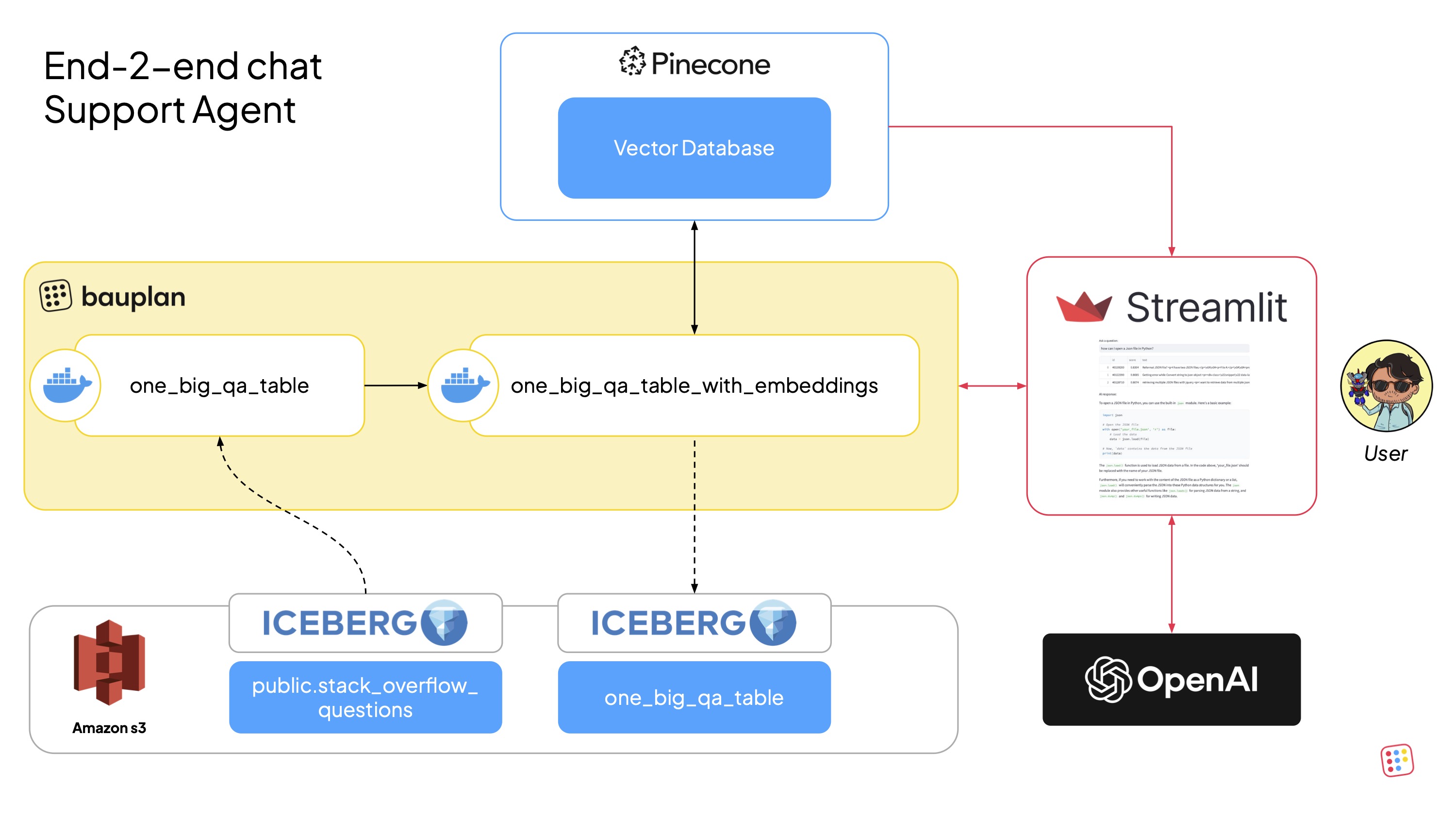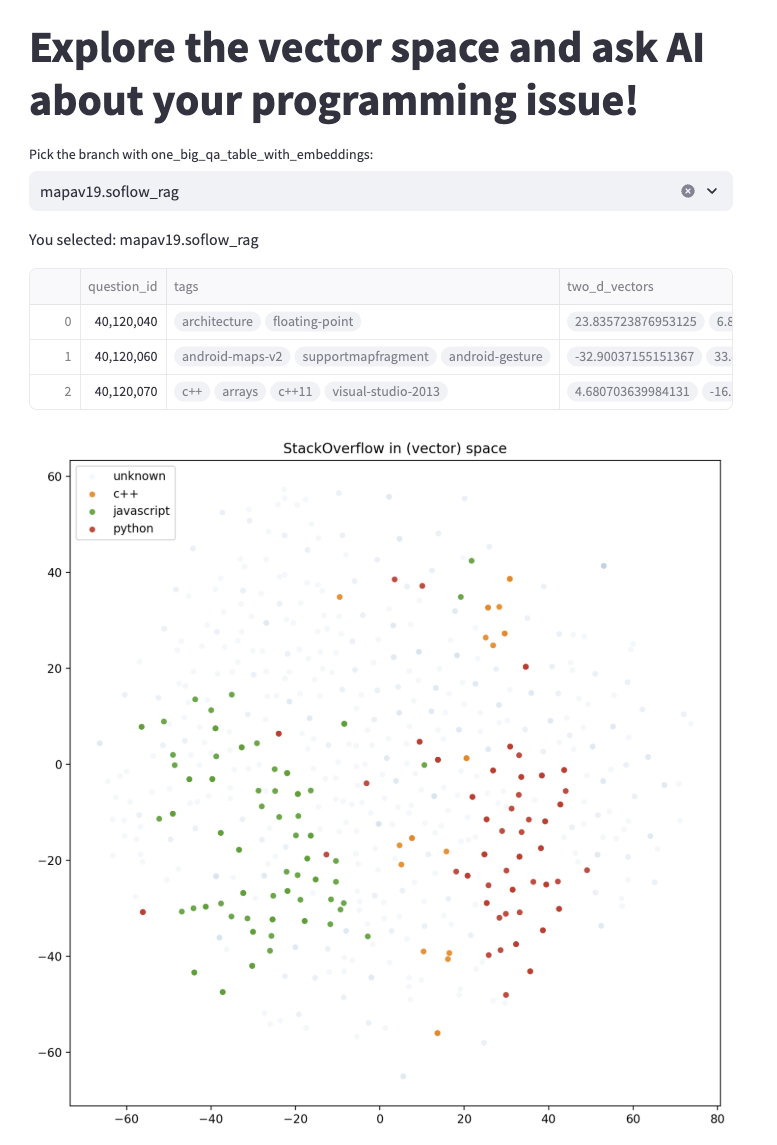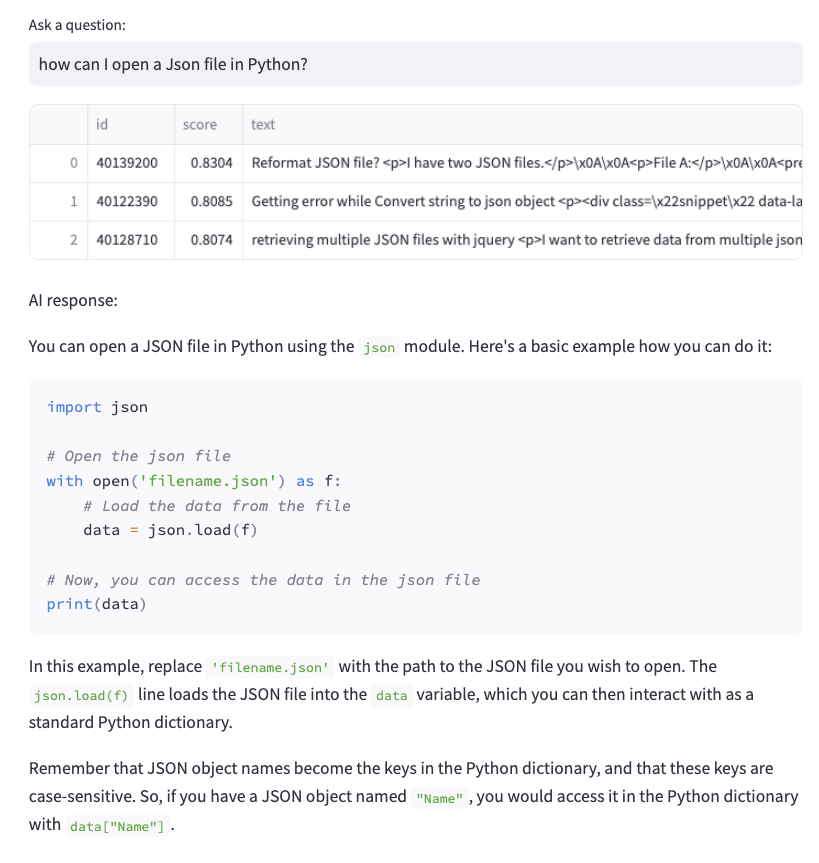RAG with Pinecone¶
Overview¶
This is a reference implementation of an end-to-end Retrieval-Augmented Generation (RAG) pipeline using bauplan for data preparation and Pinecone for vector storage and retrieval.
Use Case¶
We build a conversational support agent capable of answering technical questions using a dataset of StackOverflow Q&A. The pipeline:
Uses bauplan for data ingestion, joining, transformation, and exploration.
Generates text embeddings via Pinecone’s API and stores them in a vector database.
Includes a Streamlit app to explore the embedding space and interact with a natural language Q&A interface powered by Pinecone and OpenAI.
Q&A data is sourced from the Kaggle StackSample Dataset, available in the bauplan sandbox.
Architecture & Data Flow¶
- Data source: The StackOverflow dataset (questions, answers, tags)
is available as Iceberg tables in the
publicnamespace of bauplan.
- Pipeline: Defined in
src/bpln_pipeline, the pipeline processes, embeds, and stores the data in both Pinecone and S3 as an Iceberg table.
- Pipeline: Defined in
- Data App: The Streamlit app in src/app retrieves data for
exploration and serves as a UI for live Q&A using Pinecone and an LLM (e.g., OpenAI).

Setup¶
Python Environment¶
Ensure Python 3.10+ is installed, and use a virtual environment:
python3 -m venv venv
source venv/bin/activate
pip install -r requirements.txt
Bauplan¶
- Join Bauplan and create your
username + API key.
- Complete `the 3-minute
tutorial <https://docs.bauplanlabs.com/en/latest/tutorial/index.html>`__.
Several public datasets will be accessible in the sandbox, including the one used here.
Pinecone¶
- Create a cluster on
Obtain your API key from the Pinecone dashboard.
OpenAI¶
- Get an OpenAI api key to
call their APIs.
Running the Project¶
Explore the Dataset¶
You can use the CLI to inspect table schemas in the data catalog:
bauplan table get public.stack_overflow_questions
bauplan table get public.stack_overflow_answers
bauplan table get public.stack_overflow_tags
To explore the data, you can use Bauplan query engine directly in the CLI. For example, let us run a query to explore tag distribution:
bauplan query "SELECT tag, COUNT(*) AS _C FROM public.stack_overflow_tags GROUP BY 1 ORDER BY _C DESC"
Run the Data Pipeline¶
First of all, create a data branch and checkout to it - remember that you will need your username for this:
cd src/bpln_pipeline
bauplan branch create <YOUR_USER_NAME>.soflow_rag
bauplan branch checkout <YOUR_USER_NAME>.soflow_rag
Add your Pinecone and your OpenAI keys securely (never commit them):
bauplan parameter set --name pinecone_key --value <YOUR_PINECONE_KEY> --type secret
bauplan parameter set --name openai_key --value <YOUR_OPENAI_KEY> --type
Verify the parameter in bauplan_project.yml in the folder
src/bpln_pipeline. Then run the pipeline:
cd src/bpln_pipeline
bauplan run
The run will write a new table called
one_big_qa_table_with_embeddings in your active data branch. To
check the resulting table run:
bauplan table get one_big_qa_table_with_embeddings
Run a query to see the data inside the table:
bauplan query "SELECT question_id, COUNT(*) as _C FROM one_big_qa_table GROUP BY question_id ORDER BY _C DESC LIMIT 10"
Run the Streamlit App¶
To run the Streamlit app you will simply have to run this command and provide your username:
cd src/app
streamlit run explore_and_answer.py -- --bauplan_username <YOUR_USERNAME>
The app assumes you have run the pipeline in a branch: once the app is
running, select the right branch to query the data to get started. Note
that the command streamlit run parses parameters slightly
differently, so you need to use the -- separator to pass arguments
to the script
(streamlit run explore_and_recommend.py -- --bauplan_username foo)
The app will open in your browser for embedding exploration and question
answering.


License¶
The code in this repository is released under the MIT License and provided as is.